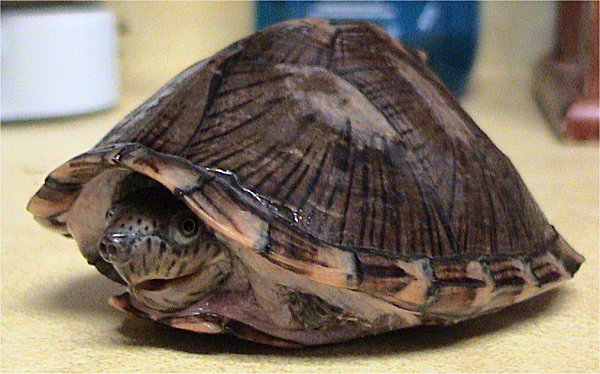|
| 질의: description | 결과: 9662번째/10150 | |
Razorback Musk Turtle (Sternotherus carinatus) - Wiki
| 제목: | Razorback Musk Turtle (Sternotherus carinatus) - Wiki
| |

| 해상도: 600x374
파일크기: 62419 Bytes
등록시간: 2007:10:10 13:06:45
|
Sternotherus carinatus
From Wikipedia, the free encyclopedia
[Photo] Razorback Musk Turtle (Sternotherus carinatus) at Austin Reptile Service. Photographer: LA Dawson (http://en.wikipedia.org/wiki/User:Dawson)
The Razorback Musk Turtle (Sternotherus carinatus) is a species of turtle native to the United States, in the states of Oklahoma, Arkansas, Mississippi, Texas and Louisiana.
Description
The Razorback Musk Turtle grows to approximately 6 inches (15 cm) in length. They have a brown colored shell, with black markings at the edges of each scute. Their shell has a distinct, sharp keel down the center of its length, giving the species its common name. The body is typically grey-brown in color, with black spotting, as is the head, which tends to have a bulbous shape to it. They have a long neck, short legs, and a sharp beak. Males can usually be distinguished from females by their longer tail.
Behavior
Musk turtles are almost entirely aquatic, spending most of their time in shallow, heavily vegetated, slow moving creeks, or ponds. The only time they typically venture onto land is when females lay their eggs. Their diet consists of primarily aquatic invertebrates, including freshwater clams, crayfish, snails, and various insects. They also feed on fish and carrion.
In captivity
The Razorback Musk Turtle is frequently found in captivity, and is regularly captive bred. Its relatively small size, and ease of care makes it a more attractive choice as a pet turtle for many keepers, than the more commonly available Red-eared Slider (Trachemys scripta elegans).
http://en.wikipedia.org/wiki/Sternotherus_carinatus
| The text in this page is based on the copyrighted Wikipedia article shown in above URL. It is used under the GNU Free Documentation License. You may redistribute it, verbatim or modified, providing that you comply with the terms of the GFDL. |
|
^o^
동물그림창고 똑똑전화 누리집
^o^
|
|